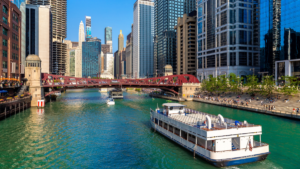Secure Spaces: Identifying and Planning for the Worst
01/26/2018
By Ronnie L. Garrett
In a world where mass shootings and copycat events prevail, event planners are currently grappling with how they might better protect event venues from mass terror without impacting the experience for their audience.
Gregg McManners, executive director of Monona Terrace Community & Convention Center in Madison, says, “The landscape of security in public venues had changed long before the Las Vegas shooting. We have an obligation to customers and employees to make sure our security systems and processes are geared toward today’s security threats. At Monona Terrace, like many other venues in the state and across the country, we have had to make significant investments in the building to update our security readiness. Today’s issues are much different than issues we faced in the late 1990s when Monona Terrace opened.”
Unfortunately, even with all the preparation McManners describes, the reality is that, as the recent Las Vegas shooting at a Jason Aldean concert proved, no amount of planning and preparation is guaranteed to stop every lone wolf shooter.
Attorney Steven Adelman, who focuses on event security, says it’s impossible to plan for an emergency that has never happened before. “There is no previous shooting like this one. It is literally unprecedented in the world of live events,” he says.
IDENTIFYING THE RISKS
What are the reasonably foreseeable threats to which people should be paying attention? To this Adelman answers, “The same stuff as before the Route 91 festival shooting.”
When planning security for any event, there needs to be a site-specific analysis based
on geographic risks. Risk analysis should include the following:
- What types of disasters are most likely to occur at this venue (fire, bomb threat, etc.)?
- What type of weather related events could impact the event (snowstorm, tornado, etc.)
- What is the worst thing that could happen?
This discussion and analysis should begin as early as the site inspection. Planners should inquire about the venue’s security measures in order to gain a basic understanding. What is standard practice in terms of security and why? Most likely the venue will have a security plan that you can start from and enhance as needed.
Other security protocols to inquire about and understand, include: how extensive is the video surveillance and monitoring and is it fully functional; are rooms secured by key cards and can the property track everyone that accesses the room?
And don’t forget to consider the area outside of the facility. What is the neighborhood like? What type, if any, recent crime has taken place in the vicinity? Consider reaching out to local authorities to gain a better understanding of any additional threats that exist in nearby areas where attendees may frequent, such as restaurants and attractions.
DEVELOPING YOUR PLAN
After planners understand the risks, next, clearly outline how you will handle each should they occur. Relationships and guidance from site security personnel and local law enforcement will be important. Reaching out to them as soon as you’ve committed to a venue is key.
Once you have a plan, educate all staff and volunteers. Review all security plans in preplanning sessions. Upon arrival at the site, include facility walkthroughs and conduct evacuation drills. Map out emergency routes and distribute to all involved.
Include evacuation and emergency information with all attendee materials and event apps, as well as all staff materials. Detail how they will be informed should something occur.
Develop a detailed emergency contact list with emails, phone numbers, cell numbers and any other pertinent information. This list should include local emergency managers for medical, fire and police. You should contact each ahead of time to inform them of your event and ask any needed questions and give them one point of contact within your team should they need to reach anyone or vice versa.
Creating a communications plan that details how critical information will be disseminated, by whom and to who is important. How will you reach emergency personnel? What about vendors and attendees on site or off site?
Many event organizers design apps to help people navigate and enjoy the festivities. These apps can also be equipped to push emergency messages to patrons, as well as notify people quickly on their cell phones about shots being fired and from where, and guide them to exit points.
Perimeter security is another area worthy of consideration. Event patrons now expect to have their bags checked before entering a venue; if they are even allowed to carry a bag in. They know that they will be wanded or asked to walk through a magnetometer for screening. “I think most people shrug these things off as the cost of living in the public in 2017,” Adelman says. “These basic protections of an event perimeter should not change because of the Las Vegas shooting; the security perimeter in this case was not breached.”
For those of you wondering how you can possibly protect your event from all of the unending threats we face in the world today, Adelman offers this advice: “I’m a realist. I don’t think it’s practical for most event organizers to consider these things. There are lots of big ideas going around, and none of them are bad ideas; they all should get some consideration because we don’t want this to happen again. But if we change much of what we do in response to something that in this case is literally unprecedented, then I think we will have reacted too much and created a new system that will then have to be fixed because it won’t be well suited to the ordinary risks that we know happen on a regular basis.”
TIME IS OF THE ESSENCE
In the case of a shooting, unfortunately the reality is that it’s unlikely law enforcement would be able to reach the threat in time to prevent it. So knowing what to do in the unlikely chance this could happen could save your life.
“The usual response is that we are all taught is run, hide, fight,” according to Adelman. “If you can run away from the shooter, do it, because it’s by far the best choice. If you can’t run away, hide behind whatever is available, and if neither of those is an option, fight the shooter with whatever you have.
Throw your coffee cup, your phone, a book. These are the rules; the problem is they are hard. They are many impediments to people running, hiding or fighting, particularly in live event spaces.”
“Event personnel need to be taught how to safely move people quickly and decisively toward a safe place. That’s ordinary crowd management. There is nothing active shooter specific about it,” says Adelman.
“But it’s really important. We need to teach the people working these events how to be shepherds, by first explaining to them how people react in emergencies, giving them active shooter training and then teaching them how to get people to safety.”











